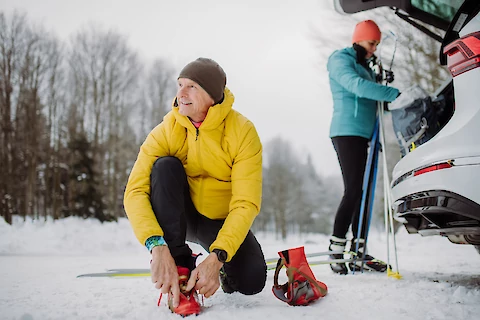
Six Tips for Seniors Enjoying Winter Sports
Year-round exercise is important for seniors. It promotes balance, helps bone density, boosts mental wellness, and provides opportunities for socialization. Winter conditions, however, discourage many from "getting out there" and keeping up with their physical activity. Here are a few tips to help seniors safely prepare for their favorite winter sports.
1. Watch the Weather
Seniors who live in the St. Louis area are fortunate to escape extreme winter conditions during most of the season. However, that doesn't mean they won't encounter surprises. They should use a reliable weather app or refer to National Weather Service reports for Lake St. Louis when planning their activities, and right before they get ready to go.
Outdoor temperatures below 60°F place seniors at a higher risk of health problems. Cold temperatures constrict blood vessels and arteries and force the heart to work harder. Those with existing heart and circulatory issues, particularly arteriosclerosis, should consult with their physician for special recommendations for outdoor winter sports.
2. Wear the Right Clothing
Dressing in layers is the best way to regulate body temperature, and base layers are the most important component of outdoor workout gear. Seniors should choose socks, leggings, and a long-sleeved undershirt made from merino wool or merino polyester blend that will stay warm when damp.
Mid-layers could include a light polyester fleece sweater and pants, and outer layers should repel wind and water without sacrificing breathability. Other components can include a puffy vest filled with down or synthetic loft, warm gloves, mittens, or "glommets"—glove and mitten hybrids—to help keep extremities warm. Hats and ear coverings are essential in cold weather and, like base layers, should remain warm when wet.
Seniors with restricted mobility or dexterity should take care to choose clothing items they can easily don and doff as needed. A good layering strategy requires the wearer to remove layers when they're warm, and add them when they're cold. The goal is to eliminate sweating, which can lead to hypothermia.
3. Choose Footwear Appropriate for the Season
Athletic shoes or hiking boots should have adequate ankle support to avoid injury in poor footing, and soles appropriate to the environment. Where the ground is snowy or icy, seniors should use removable traction devices that aren't likely to come off in the middle of a walk or hike but are easy to put on and take off.
4. Limber-Up and Warm Up
A stretching routine helps loosen muscles and joints and encourages blood flow. Many stretching exercises, including yoga, also help increase balance and coordination. Seniors can complete their stretching exercises several minutes before they begin their exercises, as studies show that stretching immediately before a workout might not be as effective.
Seniors shouldn't go from zero to 60 when beginning winter sports activities. Warming up with a stroll that begins at a normal pace, then progresses to a fast walk is a good way to get the body ready for more stringent exercise.
5. Prepare for Emergencies
No matter the activity, seniors are at higher risk of injury. This is why they should bring with them the following:
- A charged cell phone to call for help in case of an emergency
- A satellite messaging system to reach emergency services or check in with loved ones outside of cell range
- First aid kits, including prescription medications, tailored to the senior's activity
Anyone going out for a walk, hike, or any activity off the beaten path should leave word with a trusted friend telling them where they're going and when they should be expected back.
6. Take a Buddy
The best way to safely stay fit in winter and enjoy the outdoors here in the Lake St. Louis, Warrenton, and Bowling Green areas is to bring along a friend. Seniors can find an activity club to meet new people or create their own among friends and neighbors. And when they come home, if they need assistance with day-to-day chores, need respite care, or just want someone to check in, Senior Helpers of Lake St. Louis can help. Contact us to learn more about our services!